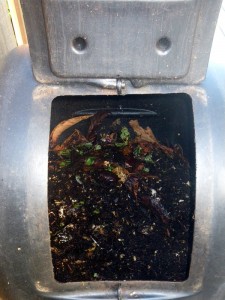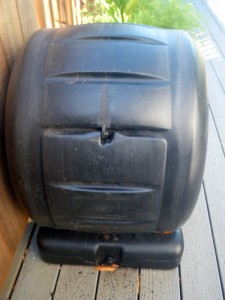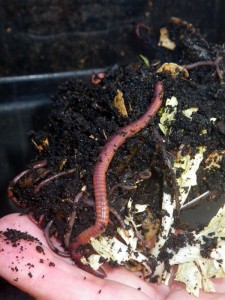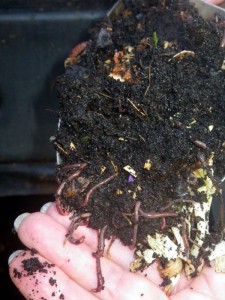Composting is one of my favorite subjects. How many ways can you take garbage and turn it into gold. The only way I know is by composting your kitchen and yard waste and getting Garden Gold as the result.
There are few additions to the garden that are as useful as compost. You can’t use too much of it, it won’t burn your plants like too much nitrogen and it increases the entire health of the soil as well as the plants. It is easy to put your kitchen wastes and some dried leaves in the bin and let the worms do their thing.
In the picture on the left, you put the food in the little trap door. Mix your wet garbage like food scraps with dry matter, like leaves, weeds and sawdust at the rate of 1 part wet to 4 parts dry. Introduce worms into the bin, either by putting some topsoil from your garden into it, or buying some earthworms from the nursery. You can also find that a little manure added will get your compost going fast.
The difference between a “hot” compost pile and a “cold” pile is the rate of decomposition and the heat generated by the breakdown of nutrients. In the bin on the left, regular additions of kitchen waste keep the pile cool, and worms find that they like this atmosphere just fine. Piles that get too hot do not have worms. Both kinds of composters work. It is more a matter of how you use your pile that decides which way it goes, hot or cold.
This set of photos shows a partial break down of the food. Worms did all the work.
From this point on you can put the compost into the soil around your plants. You’ll also be introducing more worms into the soil which is a spectacular thing to do.
There is lots more to know and learn about composting and worms, but I really just want you to get started. Here is an interesting article that will tell you more on worms. Never throw another banana peel away. Your edible landscape will be healthier and produce better tasting food using this free garden gold.
7 Responses to “Easy Composting for the Edible Landscape”
Sorry, the comment form is closed at this time.

 Follow
Follow





[…] kind of soil you have, be sure to loosen it and add compost. By aerating your soil and adding humus you will increase oxygen, nutrients and drainage, which […]
[…] in those plants that came out of your ground and you can put those nutrients back into the soil. Composting is an important part of garden […]
[…] […]
I have recently started a blog, the information you offer on this site has helped me greatly. Thanks for all of your time & work. “There can be no real freedom without the freedom to fail.” by Erich Fromm.
[…] love coffee grounds. You can safely put them into your worm bins. Enjoy a cup of coffee while walking around your garden in the morning : Uncategorized : […]
Hi Avis,
We’ve met before, I’m a surf kayaker and have competed with your sons, I actually stayed at your wonderful home many years ago. My wife and I just bought a house here in southern California, and one of our goals is to make it as earth friendly as possible, and one of the things I’d like to do is start composting. Do you know of a good “primer” for composting? Like what to put in, what not too, etc? I’m going to be doing a lot of pruning back overgrown bushes, can I add too much woody material? Do I need to add worms? Those are the kind of questions I currently have.
Geoff
Hi Geoff, Thanks for reading the blog! Composting can be really simple if you follow a few basic rules. Keep the wet, which has a lot of nitrogen in it (like kitchen waste and greens from the garden) to dry which has a lot of carbon in it (like dry leaves, dry clippings, sawdust) ratio about 10 :1. Or more simply, more dry than wet and see how it goes. If it gets too soggy, then add some dry stuff. If it just sits there doing nothing, add some more wet garbage. A good primer for compost is a little manure if you have a horse stable nearby. Or even some good topsoil which has microbes and worms already in it. You can add too much woody material, which slows the process down, but it all eventually breaks down. I like to say, “Life composts!” Hopes this helps. There are lots of sites on the web that give more complicated and exact ratios, but I find them discouraging, feeling like I’ll never get it just right. So my philosophy is, Throw it on the pile.